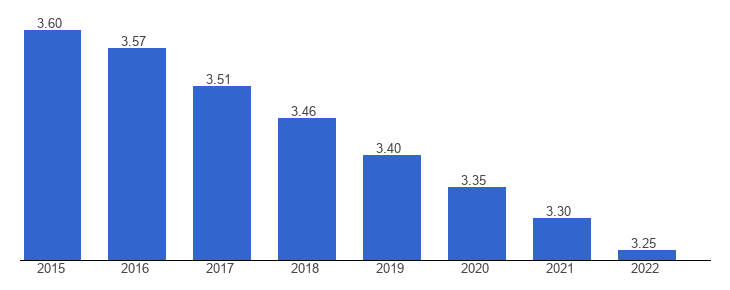Namibia, a country known for its vast deserts, stunning landscapes, and rich cultural heritage, has seen significant changes in its demographic structure in recent decades. One of the most noteworthy developments is the decline in its Total Fertility Rate (TFR), which reached a historic low in the 2022 Census. This article explores the factors behind this demographic shift, its implications for Namibia’s future, and how it fits into broader global trends.
What is Total Fertility Rate (TFR)?
Before diving into Namibia’s TFR trends, it’s essential to understand what the Total Fertility Rate is. TFR refers to the average number of children a woman is expected to have during her lifetime, based on the current age-specific fertility rates. A TFR of around 2.1 is considered the replacement level, meaning that, on average, each woman has enough children to replace herself and her partner in the population. When a country’s TFR falls below this replacement level, it can signal long-term population decline unless offset by immigration.
Namibia’s Historic Low Fertility Rate
According to the 2022 census data, Namibia’s TFR has dropped to 2.7 children per woman. This marks a significant decline from previous years, reflecting both a global and national shift in family planning practices. While Namibia’s TFR is still above the replacement level of 2.1, it is much lower than in earlier decades when it was considerably higher.
For instance, in the early 1990s, the TFR in Namibia stood at approximately 5.0 children per woman. This dramatic decline indicates a profound change in societal values, economic conditions, and access to health services.
Factors Contributing to the Decline in Fertility
Several key factors contribute to Namibia’s historically low fertility rate, many of which mirror trends seen across sub-Saharan Africa and the globe. These include:
1. Increased Access to Family Planning and Contraceptive Methods
One of the most significant drivers behind Namibia’s decline in fertility is the widespread availability and use of modern contraception. Over the past few decades, access to family planning services has expanded dramatically, especially in urban areas. The government, along with non-governmental organizations (NGOs), has been actively involved in providing education on reproductive health and making contraception more accessible to women, especially in rural areas.
As more women gain control over their reproductive choices, the decision to have fewer children becomes more common. In Namibia, contraceptive use has risen steadily, with government programs encouraging both men and women to take responsibility for family planning.
2. Improved Education and Empowerment of Women
Education has played a crucial role in reducing fertility rates in Namibia. As girls and women gain better access to education, their life choices and opportunities expand. Educated women tend to marry later, have children later, and have fewer children overall.
In addition, increased female participation in the workforce and leadership positions has contributed to the desire for smaller families. Women who are employed or have higher levels of education often prioritize their careers, personal development, and financial stability over starting large families.
3. Economic Factors and Urbanization
Urbanization has been another significant factor influencing fertility rates. As Namibia’s population becomes increasingly urbanized, the cost of raising children in cities rises, leading many couples to opt for smaller families. The pressures of modern life, such as higher living costs, limited housing space, and the need for both parents to work, contribute to the trend of having fewer children.
Furthermore, Namibia’s improving economic conditions have created a more stable society, which in turn has led to lower fertility rates. In times of economic stability, people tend to invest more in their careers and education, and as a result, families opt for fewer children.
4. Changing Social and Cultural Norms
Cultural norms regarding family size have evolved significantly in Namibia. In the past, larger families were often seen as a sign of prosperity and social status, especially in rural areas. However, with the advancement of education, media exposure, and international travel, attitudes toward family size are changing. Many young Namibians now view smaller families as more economically viable and socially desirable.
Social movements advocating for women’s rights and gender equality have also influenced the changing dynamics around marriage and childbearing. Many young Namibians are waiting longer to marry and starting families later in life, which naturally leads to fewer children.
5. Health and Mortality Improvements
Improvements in healthcare, including maternal health and child survival rates, have reduced the perceived need for larger families. In the past, families often had more children to compensate for higher infant mortality rates. However, as child survival rates improve and maternal healthcare becomes more accessible, people feel more confident in having fewer children.
Better nutrition, sanitation, and access to healthcare services have contributed to the overall decline in mortality, resulting in lower fertility rates as well.
Implications of Namibia’s Declining Fertility Rate
The decline in Namibia’s fertility rate presents both challenges and opportunities for the country’s future. While a smaller population may ease the strain on resources, it also poses several long-term challenges.
1. Aging Population
As fertility rates decline, the proportion of elderly individuals in the population increases. In the coming decades, Namibia will face the demographic shift associated with an aging population, which could place significant pressure on social services, healthcare, and pensions. The government will need to invest in elderly care services and social security systems to support an aging population.
2. Shrinking Workforce
With fewer children being born, Namibia’s labor force could shrink in the coming years. This decline in the working-age population may lead to labor shortages and place additional strain on the country’s economy. To counter this, Namibia will need to focus on increasing labor force participation, investing in automation and technology, and encouraging immigration to fill gaps in the workforce.
3. Economic Transition
On the positive side, a smaller, more educated population may lead to an economic transition from a primarily agricultural society to one that is more focused on industry, technology, and services. As fertility rates decline, governments may have more resources to invest in social programs, infrastructure, and technological advancements.
Additionally, a smaller population may allow for more effective resource management, reducing pressure on Namibia’s natural environment.
4. Impact on Education and Healthcare
A declining fertility rate could alleviate some pressure on Namibia’s education system and healthcare facilities. With fewer children, the government may be able to invest more in quality education and healthcare for the younger generation. This could lead to higher education outcomes, better employment opportunities, and an overall higher standard of living.
However, the challenge will be ensuring that the country continues to invest in programs that support young people, particularly those in rural areas, who may still face limited access to education and healthcare services.
Namibia’s declining fertility rate, as highlighted in the 2022 census, marks a significant shift in the country’s demographic landscape. The decline reflects broader global trends seen in many developing countries, where access to education, healthcare, and family planning services is transforming traditional family structures.
As Namibia navigates this demographic transition, it will need to address the challenges of an aging population and a shrinking workforce. However, the opportunities presented by a smaller, more educated population also offer the potential for economic growth, innovation, and improved quality of life. The future of Namibia’s population depends on how well the country adapts to these changes, invests in human capital, and leverages its demographic trends to create a prosperous and sustainable future.
Join 'Namibia Today' WhatsApp Channel
Get the breaking news in Namibia — direct to your WhatsApp.
CLICK HERE TO JOIN












